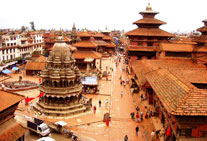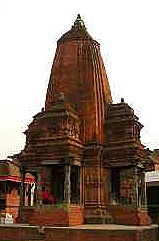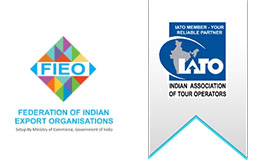NEPAL TOURS
Nepal
Bhaktapur

Located about 20 km east of Kathmandu in the Kathmandu Valley, Bhaktapur is known as the 'City of Devotees', the 'City of Culture', the 'Living Heritage', and 'Nepal's Cultural Gem'. It is one of the 3 royal cities in the Kathmandu Valley. The others are Kathmandu, the capital of Nepal, and Patan.
Bhaktapur is filled with monuments, most terra-cotta with carved wood columns, palaces and temples with elaborate carvings, gilded roofs, open courtyards. The city is dotted with pagodas and religious shrines.
Lying along the ancient trade route between India and Tibet, Bhaktapur is surrounded by mountains and provides a magnificent view of the Himalayas.
Lying along the ancient trade route between India and Tibet, Bhaktapur is surrounded by mountains and provides a magnificent view of the Himalayas.

Trivia & Quick Points:
Also called Bhadgaon and Khwopa (in the native tongue)
Religions: Hindu 92%, Buddhist 7%
Castes: Newar 63%, Brahman 10%, Chettri 18%, Tamang 5%
Bhaktapur's population is approximately 225,000
Main agricultural production: paddy, wheat, corn, pulse, millet, citrus, guava, pears, junar, haluwabed, cauliflower, peas, beans, cucumber, and pumpkin
Bhaktapur depends on tourism for about 60% of its revenues
No cars are allowed in Durbar Square; no heavy vehicles in central Bhaktapur
Facts and Information:
History
Founded in the 12th century by King Ananda Malla (according to various chronicles), Bhaktapur was the capital city of the Greater Malla Kingdom until the 15th century and was an independent kingdom from then until the 18th century.
The last three Malla rulers of Bhaktapur were Jitamitra Malla, Bhupatindra Malla, and Ranjit Malla. These rulers played key roles in building the palaces and temples of Durbar Square.
In 1744, Prithvi Narayan Shah, descendent of Dravya Shah, who was the founder of the Gorkha dynasty, began a conquest march in the Kathmandu Valley, capturing and unifying Kathmandu, Bhaktapur, and the smaller towns of the Valley under one rule.
After a period of instability and a bloody coup in 1846, Jang Bahadur Kunwar Ranaji took control of Nepal. His Rana dynasty ruled Nepal until 1951, when the Congress Party formed a new government. In 1960, King Mahendra took control, banned political parties, and instituted land reforms. Political turmoil continued throughout the late 20th century.
In 1934, a major earthquake destroyed over 2,000 houses and severely damaged over 2,000 more homes. Over 1,000 people died in this quake. Restoration of many buildings was undertaken over the years, including efforts funded by West Germany in the late 1980's and by the U.S. in the 1990's.
Visit for more information on the history of Nepal.
Culture
Bhaktapur is filled with Hindu and Buddhist religious sites and art. Although the population is primarily Hindu, there are nineteen Buddhist monasteries (Vihars). At Indra Varna Madavihar, built in 1671 and located between Durbar Square and Dattatraya Square, visitors can see two lion statues, a Patinga Hiti (water spout), Tantric wood-carved windows, and prayer wheels.
There are also many Buddhist monuments and shrines, including Lokeswor Mahavihar, Prasannasheel Mahavihar, Chatu Brahma Mahavihar, Jaya Kirti Mahavihar, Sukra-varna Mahavihar, Dipanker Mahavihar.
Many festivals are celebrated throughout the year to mark the seasons, pay tribute to gods, and remember historical and legendary events. A few of these are:
* Dashain, the longest festival of the year, lasting 15 days. This festival honors the goddess Devi Durga, who is said to have slain the demon Durga, son of Ruru. Celebrants perform many pujas (offerings) during this festival, including thousands of animal sacrifices. (September/October)
* Gai-Jatra, the Cow Festival. This festival focuses on families in bereavement. Every family who lost a relative in the past year participates in a procession with a cow or a young boy dressed as a cow. The cow, it is believed, helps the deceased reach heaven. (July/August)
* Bisket Jatra, the Nepalese New Year celebration, in which chariots are pulled through the streets and ultimately a tug of war over them determines who will be blessed with good fortune in the coming year. This celebration is also observed with picnics and other private get-togethers. (April)
* Tihar, the festival of lights, honors Laxmi, the goddess of wealth. The Nepalese light up their homes with candles, oil lamps, and other lights to invite the goddess Laxmi in.
They also worship crows, dogs, and cows during this festival and set aside one day to honor brothers. The Mha puja, a day of revering one's own body and life, is celebrated on one day of this festival. (October)
* Handicrafts Tourists can watch potters create works of art in the Pottery Squares. Indigenous (Newar) handicrafts include paubha scroll paintings, papier-mâché masks, cotton cloth, woodcarvings, metalwork, jewelry and ceramic products, haku-patasi (black sari), black caps and Juju-dhau (yogurt).
Travel and Tourism
Bhaktapur is rich in architectural beauty, filled with ancient Hindu and Buddhist religious sites, and palaces and courtyards where tourists can easily spend days absorbing the traditions and culture of the Newars.
Bhaktapur's Durbar ('Royal') Square was added to the list of World Heritage Sites by UNESCO in 1979.
Highlights & Features of the City and Surroundings:
Durbar Square
Almost 1/3 of the ancient temples, monasteries, and other ornate buildings were destroyed in the earthquake of 1934. Yet many gems remain.
In Durbar Square, tourists will find the 55-Window Palace, which served as the seat of royalty prior to 1769. The palace has elaborately carved windows and doors and houses the National Art Gallery, with Buddhist Paubha scroll paintings, palm leaf manuscripts, and stone carvings.
Just outside the palace, at the entrance to the Taleju Temple Complex is the Golden Gate, built in 1756, a splendid example of Repoussé metalwork. There also lies the Royal Bath, with its Golden Faucet.
Durbar Square is also home to the Big Bell, built by the last Malla king of Bhaktapur, Ranajit Malla in the 18th century. It was rung to pay homage to the Goddess Taleju and to harken the public to town meetings.
Today it is rung twice a day as a tribute to the Goddess Taleju. Next to this bell is the Barking Bell, so named because dogs bark to its ring.
Also in the Square lies the Yaksheswor Mahadev Temple, built by Yaksha Malla in the 15th century. It was modeled after the Pashupatinath temple in Kathmandu and was designed with ornate wooden struts decorated with erotic carvings.
Other sites in and around the square include the octagonal Chyasin Mandap, Siddhi Laxmi Temple, Shiva Temple (Fasi-dega), Vatsala Temple, Bhandarkhal Complex, Chatu Brahma Mahavihar, Indrayani Temple, Balakhu Ganesh Temple, Tripura-sundari Temple and the Char Dham symbolizing the four greatest Hindu pilgrimage sites.
The Phasi Dega Temple, dedicated to Lord Shiva, affords expansive views of the entire city.
Taumadhi Square
nayatpol-temple The Nyatpol (or Nyatapola) Temple, dedicated to the Goddess Lakshmi, lies in this square. Built in 1702 with 5 stories, this is Nepal's tallest pagoda temple.
It's struts, doors, windows, and tympanums are decorated with carvings of divine figures, including a pair of 2 m high stone statues of the legendary Rajput wresters-Jaimal and Pata; a pair of elephants, a pair of lions, a pair of griffons and a pair of tantric goddesses known as Singhini and Toyahagrini.
The Bhairavnath Temple, which was destroyed by an earthquake in 1934 and subsequently rebuilt, houses a gilded bust of the terrifying Bhairav, considered either a manifestation of Lord Shiva or a deity that guards his home.
Also here are a Pottery Square and the Temple of Jeth Ganesh, dating back to the 14th century.
Dattatreya Square
In this square, lie many of Bhaktapur's Hindu monasteries, called maths, as well as temples and museums. The three-story pagoda-style Dattatreya Temple, with statues of the Hindu trinity, was built by King Yaksha Malla in 1428. It is claimed that the building was constructed from a single piece of wood from one tree.
At the entrance are two large sculptures of the Jaiput wrestlers, Jaimala and Pata (as in the Nyatapola Temple), a “Chakra”, and a gilded metal statue of Garuda, a bird-like divinity. Around the temple are wood carved panels with erotic decorations.
During the Mohani (Dashain) festival, in the Wane Layaku complex, which lies just southwest of the Dattatreya Temple, a rare Ghau-batacha (water clock) is displayed.
The Pujari Math, which houses the Woodcarving Museum and dates back to the early 15th century, is adorned with the intricately carved Peacock Window. The Chikanpha Math, across the street, houses the Brass and Bronze Museum, with its collection of ancient Malla housewares and ritual metalware.
In Dattatreya Square, lies a Pottery Square, where potters work and display their handicrafts.
What to Do & See Around Bhaktapur
Nagarkot - The second-highest point on the Kathmandu Valley rim, Nagarkot, at an altitude of 2,175, offers panoramic views of the Himalayas and Mt. Everest. It lies 20 km northeast of Bhaktapur. The area offers hiking trails that lead into Tamang villages.
Changu Narayan - The oldest temple in the valley, build in 464 AD by Kind Mandev, the Changu Narayan lies 6 km north of Bhaktapur. A popular hiking trail leads from here to Nagarkot.
Thimi - Thimi is a traditional Newar city noted for its a vegetable garden and handicrafts. It lies about 5 km west of Bhaktapur.
Bode - This town, about a 20-minute walk from Thimi, hosts the the river-side shrine of Nil Barahi. Each year on the second day of the Nepalese New Year, the town celebrates the tongue-boring festival, in which a villager has a thin metal spike thrust through his tongue by the temple’s priest. After parading around town carrying a bamboo rack of oil lamps, the spike is removed and packed with mud from the temple floor. If no blood flows, the villager earns great respect for himself and the town; however, if blood flows it is considered a bad omen for the coming year.
Surya Vinayak Shrine - The Surya Vinayak is just a 10 to 20 minute walk from Bhaktapur and attracts visitors and locals praying for good luck to the god Ganesh. The shrine is located in a forest at the top of a hill.
Where to Stay
Bhaktapur has no deluxe hotels but can accomodate tourists in a total of 130 standard rooms throughout the city. Information on where to stay in Bhaktapur is coming soon...
Getting There and Away
Tourists arrive in the Kathmandu Valley via Tribhuvan International Airport. Airlines flying into this airport include Royal Nepal Airlines, Aeroflot, Biman Bangladesh Airlines, China South-West Airlines,Druk Air, lndian Airlines, Pakistan International Airlines, Singapore Airlines and Thai lnternational.
Bhaktapur.com recommends comparing various airlines and ticketing agents with our Travel partner Booking Wiz.
From the airport, which lies 5.5 km east of Kathmandu, one can take taxis or buses or rent a car with a driver. One can take them back to Kathmandu from just outside Bhaktapur as well.
Getting Around
Inside the city limits of Bhaktapur, motor vehicles are not allowed. Outside the city limits, buses and taxis are available.



